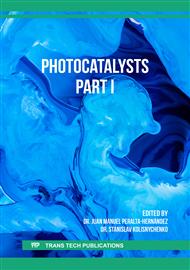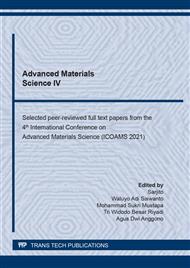[1]
J. Kolny-Olesiak and H. Weller, Synthesis and application of colloidal CuInS2 semiconductor nanocrystals,, ACS Appl. Mater. Interfaces, vol. 5, no. 23, p.12221–12237, (2013).
DOI: 10.1021/am404084d
Google Scholar
[2]
L. Liu, H. Li, Z. Liu, and Y. H. Xie, The conversion of CuInS 2 /ZnS core/shell structure from type I to quasi-type II and the shell thickness-dependent solar cell performance,, J. Colloid Interface Sci., vol. 546, p.276–284, (2019).
DOI: 10.1016/j.jcis.2019.03.075
Google Scholar
[3]
S. Suehiro et al., Efficient solution route to transparent ZnO semiconductor films using colloidal nanocrystals,, J. Asian Ceram. Soc., vol. 4, no. 3, p.319–323, (2016).
DOI: 10.1016/j.jascer.2016.06.002
Google Scholar
[4]
G. Xu, S. Zeng, B. Zhang, M. T. Swihart, K. T. Yong, and P. N. Prasad, New Generation Cadmium-Free Quantum Dots for Biophotonics and Nanomedicine,, Chem. Rev., vol. 116, no. 19, p.12234–12327, (2016).
DOI: 10.1021/acs.chemrev.6b00290
Google Scholar
[5]
H. Nakamura et al., Tunable photoluminescence wavelength of chalcopyrite CuInS 2-based semiconductor nanocrystals synthesized in a colloidal system,, Chem. Mater., vol. 18, no. 14, p.3330–3335, (2006).
DOI: 10.1021/cm0518022
Google Scholar
[6]
P. H. Chuang, C. C. Lin, and R. S. Liu, Emission-tunable CuInS2/ZnS quantum dots: Structure, optical properties, and application in white light-emitting diodes with high color rendering index,, ACS Appl. Mater. Interfaces, vol. 6, no. 17, p.15379–15387, (2014).
DOI: 10.1021/am503889z
Google Scholar
[7]
M. Booth, A. P. Brown, S. D. Evans, and K. Critchley, Determining the concentration of CuInS 2 quantum dots from the size-dependent molar extinction coefficient,, Chem. Mater., vol. 24, no. 11, p.2064–2070, (2012).
DOI: 10.1021/cm300227b
Google Scholar
[8]
Z. Long, W. Zhang, J. Tian, G. Chen, Y. Liu, and R. Liu, Recent research on the luminous mechanism, synthetic strategies, and applications of CuInS2quantum dots,, Inorg. Chem. Front., vol. 8, no. 4, p.880–897, (2021).
DOI: 10.1039/d0qi01228a
Google Scholar
[9]
B. L. Wu, H. J. Chao, C. P. Chen, C. H. Yang, and J. Y. Chang, One-pot synthesis of colloidal Cdx:CuInS2 quaternary quantum dots used as sensitizers in photovoltaic cells,, RSC Adv., vol. 5, no. 46, p.36605–36613, (2015).
DOI: 10.1039/c5ra04275e
Google Scholar
[10]
Y. Yan et al., CuInS2 sensitized TiO2 for enhanced photodegradation and hydrogen production,, Ceram. Int., vol. 45, no. 5, p.6093–6101, (2019).
DOI: 10.1016/j.ceramint.2018.12.083
Google Scholar
[11]
M. Gromova et al., Growth Mechanism and Surface State of CuInS2 Nanocrystals Synthesized with Dodecanethiol,, J. Am. Chem. Soc., vol. 139, no. 44, p.15748–15759, (2017).
DOI: 10.1021/jacs.7b07401
Google Scholar
[12]
M. Fu, W. Luan, S. T. Tu, and L. Mleczko, Green Synthesis of CuInS2/ZnS Nanocrystals with High Photoluminescence and Stability,, J. Nanomater., vol. 2015, (2015).
DOI: 10.1155/2015/842365
Google Scholar
[13]
K. Kumamoto, K. Tsuchibashi, A. D. Pramata, M. Yuasa, K. Shimanoe, and T. Kida, Visible Light-Driven Photoenergy Storage and Photocatalysis Using Polyoxometallates Coupled with a Ru Complex,, J. Phys. Chem. C, vol. 121, no. 25, p.13515–13523, (2017).
DOI: 10.1021/acs.jpcc.7b02484
Google Scholar
[14]
V. Rodríguez-González, S. Obregón, O. A. Patrón-Soberano, C. Terashima, and A. Fujishima, An approach to the photocatalytic mechanism in the TiO2-nanomaterials microorganism interface for the control of infectious processes,, Appl. Catal. B Environ., vol. 270, no. January, p.118853, (2020).
DOI: 10.1016/j.apcatb.2020.118853
Google Scholar
[15]
J. Hua et al., Composition-dependent photoluminescence properties of CuInS2/ZnS core/shell quantum dots,, Phys. B Condens. Matter, vol. 491, p.46–50, (2016).
DOI: 10.1016/j.physb.2016.03.025
Google Scholar
[16]
H. Li, X. Jiang, A. Wang, X. Chu, and Z. Du, Simple Synthesis of CuInS2/ZnS Core/Shell Quantum Dots for White Light-Emitting Diodes,, Front. Chem., vol. 8, no. August, p.1–9, (2020).
DOI: 10.3389/fchem.2020.00669
Google Scholar
[17]
T. Kida, H. Furuso, K. Kumamoto, A. D. Pramata, M. Yuasa, and K. Shimanoe, Visible-light sensitization and photoenergy storage in quantum dot/polyoxometalate systems,, Chem. - A Eur. J., vol. 21, no. 20, p.7462–7469, (2015).
DOI: 10.1002/chem.201500021
Google Scholar
[18]
J. Van Embden, A. S. R. Chesman, and J. J. Jasieniak, The heat-up synthesis of colloidal nanocrystals,, Chem. Mater., vol. 27, no. 7, p.2246–2285, (2015).
DOI: 10.1021/cm5028964
Google Scholar
[19]
M. Booth, Synthesis and Characterisation of CuInS 2 Quantum Dots Determining the Concentration of CuInS 2 Quantum Dots from the Size-Dependent Molar Extinction Coefficient, Chemistry of Materials,, J. Phys. Chem. C, p.1–164, (2014).
DOI: 10.1021/cm300227b
Google Scholar
[20]
S. G. Kwon and T. Hyeon, Formation mechanisms of uniform nanocrystals via hot-injection and heat-up methods,, Small, vol. 7, no. 19, p.2685–2702, (2011).
DOI: 10.1002/smll.201002022
Google Scholar
[21]
P. Reiss, M. Protière, and L. Li, Core/shell semiconductor nanocrystals,, Small, vol. 5, no. 2, p.154–168, (2009).
DOI: 10.1002/smll.200800841
Google Scholar
[22]
S. C. Shei, W. J. Chiang, and S. J. Chang, Synthesis of CuInS2 quantum dots using polyetheramine as solvent,, Nanoscale Res. Lett., vol. 10, no. 1, p.4–10, (2015).
DOI: 10.1186/s11671-015-0789-3
Google Scholar



